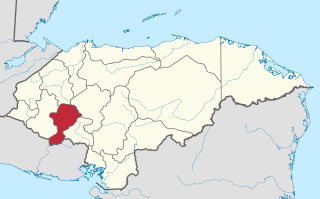
Intibucá is one of the 18 departments in the Republic of Honduras. Intibucá covers a total surface area of 1,186.1 square miles (3,072 km2). Its capital is the city of La Esperanza, in the municipality of La Esperanza.
La Paz is the capital city of the La Paz Department of Honduras. The town, founded in 1792, has a population of 30,020.
Concepción is a municipality in the Honduran department of Intibucá.
San Juan, Intibucá lies in the western highlands of Honduras between Gracias and La Esperanza.
Aguanqueterique is a municipality in the Honduran department of La Paz. As of 2001 it had a population of 4620.
Cabañas is a municipality in the Honduran department of La Paz.
Cane is a municipality in the Honduran department of La Paz.
Guajiquiro is a municipality in the Honduran department of La Paz.
Marcala is a town, with a population of 14,360, and a municipality in the Honduran department of La Paz. The region is known for its coffee production, boasting the first "protected origin denomination" for coffee. Marcala has been designated as a center of Lenca Trail, a government and United Nations sponsored development effort to encourage tourism to Lenca communities. It offers visitors perspective on the culture of indigenous people and provides new markets for their traditional crafts.
Opatoro is a municipality in the Honduran department of La Paz.
San Antonio del Norte is a municipality in the Honduran department of La Paz.
San José is a municipality in the Honduran department of La Paz.
San Pedro de Tutule is a municipality in the Honduran department of La Paz.
Santa Ana is a municipality in the Honduran department of La Paz, known for its high crime rate.
Santa Elena is a municipality in the Honduran department of La Paz.
Santa María is a municipality in the Honduran department of La Paz.
Santiago de Puringla is a municipality in the Honduran department of La Paz. The municipality is situated on a plain bordered by the River Puringla. South of the municipality runs the River Lepasale.
Yarula is a municipality in the Honduran department of La Paz.

San Marcos de Caiquín is a municipality in the Honduran department of Lempira created November 4, 1994.
Belén Gualcho is a municipality in the Honduran department of Ocotepeque. This small village founded in 1715 is a jewel in the middle of the Honduran mountains, located in the departament of Ocotepeque and close to Gracias and San Sebastian to the south. The highlights of the village are the colonial Church of La Trinidad and Sunday Market where the Lenca people come to sale and get basic supplies. In 1871, it was listed as the head of the Curato de Gualcho, later it was called Belén de Copán or Belén de Occidente; on September 2, 1907, it became part of the Ocotepeque Department, calling it Belén de Ocotepeque and on February 15, 1922 it was called Belén Gualcho, belonging to the Sensenti district. Its name according to the Mexica spelling means "House of the oaks", and in Lenca language it means "Place of many waters"



